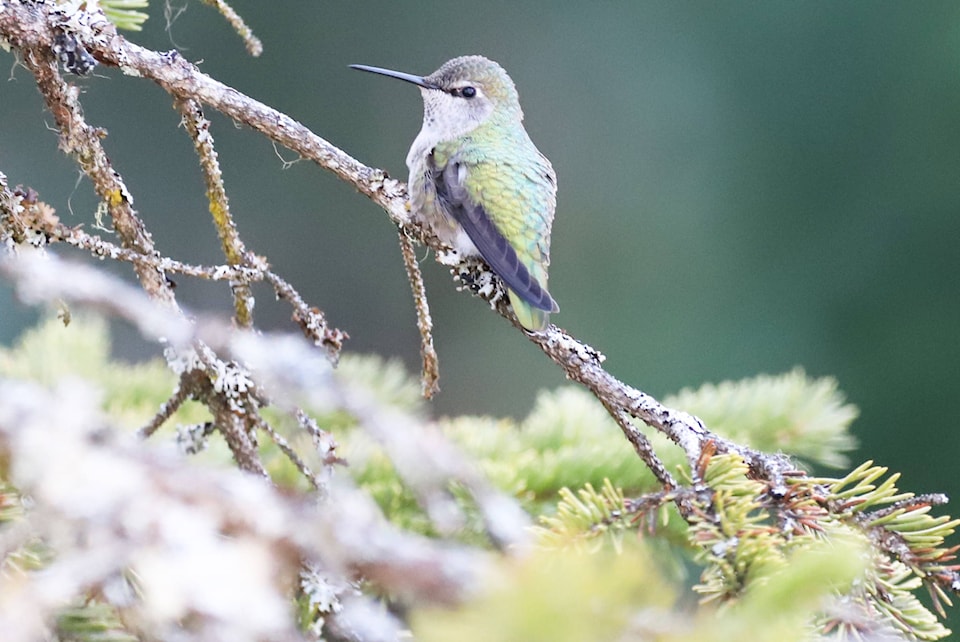Many Kitimat residents were surprised to notice they still had hummingbirds in their yards the other week, despite the cold weather and snow.
“Usually they leave — well, I’ve had them here until the first of October,” former Kitimat mayor, Joanne Monaghan, said. “And they say in the books if you don’t see a hummingbird for two weeks, then take your feeders down. Well I never saw them for two weeks and the others didn’t either, but we just left them up and all at once, there they were.”
Kitimat birding expert Walter Thorne said that Kitimat and the Northwest have two principle types of hummingbirds: the Rufous hummingbird and the Anna’s hummingbird.
“The one that we have now is called the Anna’s and for some reason it seems to be hardier for the Northern climate,” Thorne said, adding that the Rufous hummingbird is only up this north from about April to September, before travelling down the Douglas Channel and out to Mexico and Central America for the winter.
“I was talking to the bird people in Ottawa and they’re even saying now that the Anna’s hummingbirds…they’re even staying in Alaska over winter,” Monaghan said.
Thorne said they track the number of birds in the area and how that number changes throughout the year and even throughout the seasons.
“It’s hard to know for sure, but we could have as many as a dozen here right now, and Terrace has a few too, and probably Rupert does,” Thorne said. “So, there’s more in the North than you realize.”
Thorne said that it’s not uncommon to see Anna’s hummingbirds throughout the winter in Kitimat, at least for the first part.
“Even last year with the cold spell, even with below minus 10 they were still around. Even past January, past New Year’s last year,” he said. “We always worry, well, if we saw them until January does that mean they died in January or what? We don’t know, we don’t know. We think not. We think that they just had enough, so they probably headed down the channel.”
Thorne said that when they migrate, they don’t do so in packs or with other animals as they’re actually quite capable birds. However, he added that there is still much research that needs to be done in terms of these little birds and their migration habits.
“They’re quite capable of migrating on their own,” he said. “But the thoughts are that they won’t go up high and travel way up in the atmosphere. They’ll just sort of travel along the ground and forage as they go.”
Thorne added that many people think hummingbirds just eat nectar, which he said isn’t completely correct.
“There’s a misconception that it lives entirely on nectar and that’s not true,” Thorne said. “They will eat little insects too, like spiders and flies, and so they do get protein too. They will eat fruit, too.”
Many people, like Thorne and Monaghan, leave out dishes of homemade nectar for the birds in the cooler months so that they have something to eat if they stick around.
Thorne added, however, that it’s been a topic of debate in the birding community as to whether people should be doing this or not.
“The birding community is kind of split on that. Like, are you helping them or are you hurting them? There’s no clear-cut answer on that,” he said. “Those that say you’re encouraging them to stay when they should go, it’s not entirely true by the literature and what we’ve seen.”
Monaghan said she mixes a quarter cup of sugar with a cup of water, boils it, then lets it cool, and that serves as a substitute nectar for them for the winter. She added that some people try honey, but they shouldn’t because it’s too thick and the birds can’t get it up their bill as easily.
Thorne added that they’ll also eat rose hips and huckleberries still on branches, as well as other fruits and things they can find along the way.
“They’re more versatile than you really realize and they’re hardy.”
To add to their versatility, hummingbirds can also go into torpor, a state of decreased mental and physical activity which helps them survive when there is a reduced availability of food for a period of time.
And because they stay here for a while during the winter, Monaghan said she’s noticed hummingbirds going into torpor before, especially in evenings, and she commonly sees a hummingbird near the nectar during the day.
“[You] can’t have a hummingbird and just, you know, be haphazard about what you do. You have to put the food out and keep it warm so they can have it,” she said. “Keep feeding it and keep it alive.”
READ MORE: How to keep the hummingbirds fed during a cold snap
clare.rayment@northernsentinel.com
Like us on Facebook and follow us on Twitter
